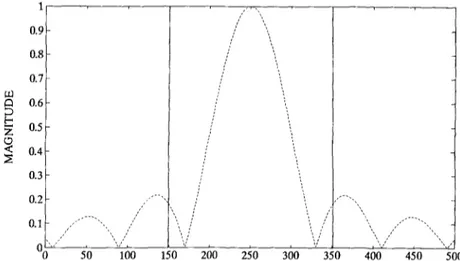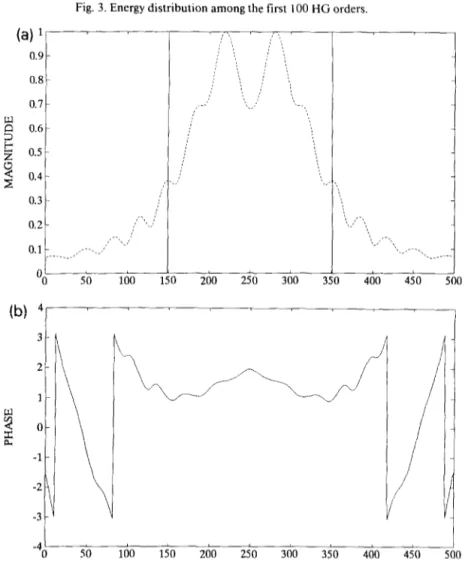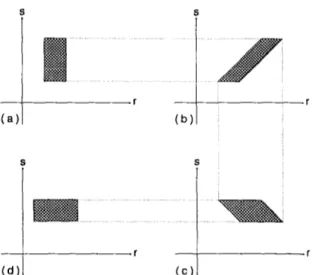Optics Communications 101 (1993) 163-169 North-Holland
OPTICS
COMMUNICATIONS
Fourier transforms of fractional order
and their optical interpretation
Haldun M. Ozaktas
Electrical Engineering, Bilkent University, 06533 Bilkent, Ankara, Turkey
and
David Mendlovic
Tel-Aviv University, Faculty of Engineering, 69978 Tel-Aviv, Israel
Received 1 I February 1993; revised manuscript received 13 April 1993
Fourier transforms of fractional order a are defined in a manner such that the common Fourier transform is a special case with order a= 1. An optical interpretation is provided in terms of quadratic graded index media and discussed from both wave and ray viewpoints. Fractional Fourier transforms can extend the range of spatial filtering operations.
The original definition of the derivatives of a func- tion makes sense only for integral orders, i.e. we can speak of the first or second derivative and so on. However, it is possible to extend the definition of the derivative to noninteger orders by using an elemen- tary property of Fourier transforms. Bracewell shows how fractional derivatives can be used to character- ize the discontinuities of certain functions [ 11. An example from the field of optics is related to the Tal- bot effect [ 2 1, in which self-images of an input ob- ject are observed at the 2D planes z=NzO for integer N (z is the axial coordinate and z0 a characteristic distance). Using a self-transformation technique [ 31, it was shown that N could also take on certain ra- tional values.
In this letter we define fractional Fourier trans- formations in a similar spirit. The 0th Fourier transform of a function S(x, y) will be denoted as .P~(x, y)], or simply S”fwhen there is no room for confusion. We require that our definition satisfy two basic postulates. First, .9iIfshould be the usual first Fourier transform, defined as
+cc +oo
(S’f) (x’, y’) =
1s
f(X> Y)--co -cc
xexp[ -i2n(x’x+y’y)/s2] tidy, (1) where S, x, x’, y, y’ all have the dimensions of length. (The parentheses on the left hand side are to em- phasize that the variables x’, y’ belong to
J’f
and not&) In a conventional “2f” optical Fourier trans- forming configuration #’ [ 41, x, y would denote the coordinate of the input plane, x’, y’ those of the Fourier plane, and s2=/lf
(A=
wavelength of light, f=focal length of lens).Our second postulate is to require that
.FO[
.~bf]=.~=_~bf=sb.~"f=sa+bf. (2)
Consistent with our two postulates, .9’lQ[ ] may be defined for integer Q as that operation which when applied Q times gives the first (conventional) Four- ier transform off: An optical system which performsxl By this we are referring to the common textbook configura- tion consisting of free-space propagation by a distancef; a lens of focal length J; and again free space propagation by a dis- tancef:
Volume 101, number 3,4 OPTICS COMMUNICATIONS I5 August 1993
this operation may be realized by inserting a lens of appropriate focal length midway between the appro- priately spaced input and output planes. It is now possible to define Fourier transforms of rational or- der
.F'/Qf
by repeated application of the operator .‘5;“Q for P times. The definition can be generalized to real orders by a limiting process.Here we will not pursue this line of thought. In- stead, we recall that the optical Fourier transforming operation is a result of the joint action of the dual operations of free-space propagation and focusing
[ 5,6 1. In a conventional “2s” system, the focusing
action is concentrated at the lens location. The same operation can be performed by Q fractional Fourier transform stages in cascade each performing .P’/Q[. 1. In this latter system, the act of focusing is evenly dis- tributed through the act of propagation. In the limit that Q+co, focusing and propagation will be infin- itesimally and uniformly interspersed between each other. Of course, bulk systems with even moderately large Q would be quite impractical. Fortunately, sys- tems satisfying this property can be realized as qua- dratic graded index (GRIN) media. Such media can be thought to consist of infinitesimal layers in which focusing and propagation take place simultaneously. The refractive index distribution in such a medium is given by [ 7 ]
n2(r)=n:[1-(n2/n,)r2], (3) where r2=X2+ y2 is the radial distance from the op- tical axis and n,, n, are the GRIN medium param- eters. By solving the ray equation, it was shown [ 71 that a parallel bundle of rays will be focused a dis- tance L- (7r/2)m away from the input plane. If a function
f (x,
y)
is presented at the input plane 2~0, at the plane z= L we observe-9'f
as given by eq. (1) [S]. (This confirms that z=L is the focal plane not only from the ray optics point of view but also from the physical optics point of view.) NOW, since the system is fully uniform in the axial direc- tion,.Ff
can be physically defined as the functional form of the scalar light distribution at z=aL.Above, we have motivated and defined the frac- tional Fourier transform in physical terms. How- ever, it is important to note that fractional Fourier transforms can be defined purely mathematically and GRIN media introduced afterwards as a physical interpretation. We now present such as mathemati-
cal definition, also showing its relation to the phys- ical definition above.
The self-modes of quadratic GRIN media are the 2D Hermite-gaussian (HG) functions [ 71, which form an orthogonal and complete basis set. The (I, m )th member of this set is expressed as
(4) where HL and H, are Hermite polynomials of orders 1 and m, respectively, o= (2/k)“‘( n1/n2)“4 with
k=21cn,/A, and J. is the wavelength. Each HG mode
propagates through the GRIN medium with a dif- ferent propagation constant [ 71
j3~,=k[l-(2/k)(n2/n,)‘~2(I+m+1)]”2
=k- (n2/n,)“2(l+m+ I) (5)
Any 2D function
f (x,
y)
can be expressed in terms of the HG basis set asf(x,
Y)' c c hn ~/*(X,Y)
I m
>
(6)
-02
where h,,=2”+“)l!m!nw’/2.
Now, the fractional Fourier transform off (x, y)
of order a can be defined as
.F[.f(x, 1:) I =
T
z
4,C,Ax, Y)
exP(ihd)
.
(8)
It was shown [8] that our two postulates are satis- fied by this definition, and that the scaling factor s appearing in eq. ( 1) is given by s= w&. In the same reference, we also discuss and prove some of the properties of fractional Fourier transforms, which are richer than those of the common Fourier trans- form #2, and generalize to complex values of the or- der a (which can be physically realized by attenuat- ing media). We also define fractional convolutions
(or correlations) through the equation
CONV”]f; g] = .P-“[ .Ff x Pg] (9) 112 For a list of properties of the common Fourier transform, see
Volume 101, number 3,4 OPTICS COMMUNICATIONS 15 August 1993
In order to demonstrate the fractional Fourier transform operation, some computer simulations have been carried out for one-dimensional signals. Let us assume that the input function is the common rectangle function. Figure I shows this initial signal and the magnitude of its first order Fourier trans- form. The phase information of the first Fourier transform is shown in fig. 2. The coefficients A, for our specific example are shown in fig. 3. This figure demonstrates the fact that in this example harmon- its of higher orders ( > 15) contain very little of the total energy. Figure 4 shows the fractional Fourier transform of order 0.25, Note that this same distri-
bution is also the fractional Fourier transform of or- ders 1.75, 2.25, . . . . Figures 5 and 6 show the frac- tional Fourier transforms of our input function for the orders 0.5, 1.5, . . . . and 0.75, 1.25, . . . . respectively.
To gain some additional insight regarding frac- tional Fourier transforms and also show its relation to ray optics, we now provide a phase-space inter- pretation. Let a particular paraxial ray be character- ized by its radial distance r and slope S, both with respect to the optical axis at a particular axial po- sition z. Then, the effect of passing through any op- tical system on this ray can be described by a move- ment in r-s space. For instance, free-space prop-
a” 0.6 2 z 0.5 3 0.4 I 0.3 1
Fig. 1. Solid curve: input signal, dashed curve; magnitude of its first order Fourier transform.
L
-*0 50 100 150 200 250 300 350 400 4.50 500 I Fig. 2. Phase of the first order Fourier transform of the input signal in the previous figure.
Volume 101, number 3,4 OPTICS COMMUNICATIONS 80- 60 - 15 August I993 -20; 10 20 30 40 50 60 70 80 90 1 HG order
Fig. 3. Energy distribution among the first 100 HG orders.
(4 l
0.9 - 0.8 - 0.7 - w c1 0.6- 2 2 0.5 - r9 2 0.4- 0.3 - ,:’ 0.2 - ,lj, ,/ ,,’ ‘.,’ ,__, : 0.1 - ,_...__;l ,’ ~.’ OO SO 100 1 : ~/ 1, 200 250 300 350 400 450 1 01 jO( -40 50 100 150 200 250 300 350 400 450Fig. 4. Fractional Fourier transform of order a=0.25, (a) magnitude, (b) phase.
I
Volume 10 1, number 3,4 OPTICS COMMUNICATIONS 15 August 1993
(4
l
0.9 0.8 0.7 I 8 0.6- 3 ti % 0.5 - a L 0.4- 0.3 -(b)
3
2.5 2 4 1.5 a 1 0.5 CFig. 5. Fractional Fourier transform of order ~~0.5, (a) magnitude, (b) phase
agation corresponds to a horizontal displacement whereas focusing by a lens corresponds to a vertical displacement. Let us now consider a bundle of rays with a uniform spread of r and s (represented by the shaded rectangular region in fig. 7a) and consider how this ray bundle is transformed as it passes through a conventional “2f” Fourier transforming configuration (fig. 7 ). The overall effect of the “2f ’
system is to rotate the rectangular region by 90”, al- though the intermediate steps result in shearing of the rectangular region.
How do things look like in phase space if we use quadratic GRIN media instead? It is known that r and s obey the following equations in such media [ 71:
r(z+Az)=r(z) cos(nAz/2L)-s(z) sin(nAz/2L), s(z+Az)=r(z) sin(nAz/2L)+s(z) cos(7rAz/2L),
(10) from which we can conclude that the region repre- senting any given bundle of rays in phase space is uniformly rotated as we go from z=O to z= L. This
uniform behavior is to be contrasted with that of the bulk “2f” Fourier transformer in which the focusing is concentrated at the lens, instead of being uni- formly distributed throughout the system. This has discouraged us from basing the definition of frac- tional Fourier transforms on conventional bulk Fourier transformers. Although we cannot exclude
Volume 10 I, number 3,4 OPTICS COMMUNICATIONS 15 August 1993
(a)
1
0.9 0.8 0.7 8 0.6- 2 z 0.5 - 3 0.4- 0.3 - ‘~ “/1
,~,,~,;:.,--....:.._
_,,,,_
{
200 250 300 350 400 450 500Fig. 6. Fractional Fourier transform of order a=0.75, (a) magnitude, (b) phase.
the possibility of other definitions consistent with our two postulates, our particular definition is seen to be a natural and meaningful one, especially in an op- tical context.
Fractional Fourier transforms can form the basis of generalized spatial filtering operations, extending the range of operations possible with optical infor- mation processing systems. Conventional Fourier plane filtering systems [ 41 are based on a spatial fil- ter introduced at the Fourier plane. This limits the operations achievable to linear space-invariant ones (i.e. operations which can be expressed as a con- volution of the input function with a space-invariant impulse response). By introducing several filters at different fractional Fourier planes, it may be possi-
ble to implement a wider class of operation. Note that full space-variant operations can be implemented us- ing approaches such as (or equivalent to) vector- matrix multiplier architectures [ 91 or multi-facet ar- chitectures [ lo], but these result in a heavy penalty in terms of space-bandwidth product utilization. A detailed treatment of how many filters are needed and how they should be synthesized to realize a given operation must be postponed for future research. Here we must satisfy ourselves by noting that this process, in its extreme, constitutes a generalization of conventional planar spatial filtering to volume spatial filtering.
Despite the attractiveness of this concept, it is per- haps worth noting that there have been some related
Volume 101, number 3,4 OPTICS COMMUNICATIONS 15 August I993
s s
,f----’
zt---r
Fig. 7. (a) Phase space representation of the original bundle of rays. (b) After free space propagation through a distance1: (c) After passage through a lens of focal length J: (d) After another free space propagation through a distancef:
attempts (not based on the fractional Fourier trans- form in GRIN media as we have introduced it), which have been very difficult to implement with ac- curate results [ 11,121. Thus, we refrain from opti- mistic conclusions regarding the usefulness of gen- eralized spatial filtering before further results are developed.
A detailed mathematical treatment of the frac- tional Fourier transform will be given in another publication [ 8 1.
Some of the ideas in this letter were developed during intensive study sessions organized by Adolf W. Lohmann at the Applied Optics Group of the University of Erlangen-Ntirnberg during the sum- mer of 1992. David Mendlovic acknowledges a MI- NERVA fellowship and Haldun M. Ozaktas ac- knowledges an Alexander von Humboldt fellowship which made this cooperation possible.
References
[ I ] R. Bracewell, The Fourier transform and its applications, 2nd Ed. (McGraw-Hill, New York, 1986).
[2] K. Patorski, in: Progress in optics, Vol. 28, ed. E. Wolf (North-Holland, Amsterdam, 1989) p. 3.
[3] A. Lohmann and D. Mendlovic, Self-Fourier objects and other self-transform objects, J. Opt. Sot. Am. A 9 ( 1992).
[ 4 ] J. Goodman, Introduction to Fourier optics (McGraw-Hill, New York, 1968).
[5] A. Lohmann, Optik (Stuttgart) 1 I (1954) 478 (in german); [Optik 89 (1992) 931.
[ 61 A. Vander Lugt, Optical signal processing (Wiley, New York, 199X).
[ 71 A. Yariv, Optical electronics, 3rd Ed. (Holt Sounders, 1985). [S] D. Mendlovic and H.M. Ozaktas, Fractional Fourier transformations and their optical implementation: Part I, J. Opt. Sot. Am. A, accepted.
[ 91 J.W. Goodman, A.R. Dias and L.M. Woody, Optics Lett. 2 (1978) 1.
[IO] S.K. Case, P.R. Haugen and O.J. Loberge, Appl. Optics 20 (1981) 2670.
[ I I] D. Gabor, IBM Journal of Research and Development 13 (1969) 156.




